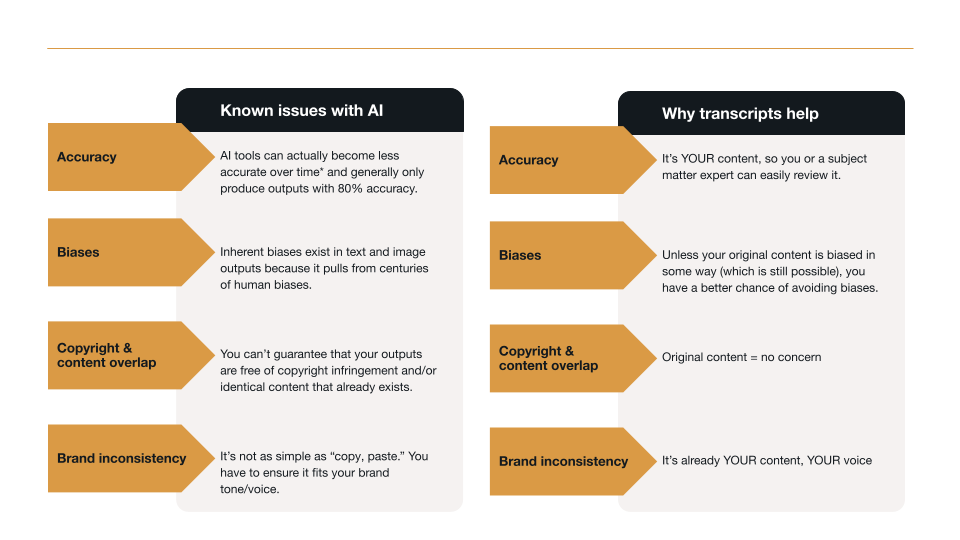A Complete Guide: Turning Transcripts Into Content with AI

In the ever-evolving world of content creation, AI tools like ChatGPT offer exciting creative possibilities but also come with their own set of challenges and pitfalls. That said, when it comes to fast-tracking content, using AI to transform transcripts into publishing gold should be a go-to strategy for content creators.
Fun fact: this article was generated with the help of AI from a live-recording of a speaking session we presented at Content Marketing World 2023!
Let’s dive in.
Table of contents
Known issues when using AI to create content, and why transcripts help
1. Accuracy concerns
AI and LLM systems are only as good as the data they are trained on, and systems like ChatGPT are not up-to-date. In fact, as of the time of this article’s publishing, ChatGPT doesn’t contain information past September 2021.
This limitation can lead to accuracy issues in content creation. For instance, AI may struggle with complex topics, nuanced language, or rapidly evolving news stories.
Transcripts to the rescue
Transcripts generated from your content are just that: your content. It’s information you’ve already vetted, so as long as you have a subject matter expert review the content prior to publishing, you should have no issues with accuracy.
2. The bias problem
AI algorithms can inadvertently perpetuate biases present in their original training data, unfortunately leading to content that reinforces stereotypes or excludes certain perspectives. Combating this requires a conscious effort—by developers and marketers alike—to use diverse and inclusive datasets, along with continuous monitoring and adjustment of AI algorithms.
Why transcripts help
Unless your original content is biased in some way, you have a better chance of avoiding biases present in AI-generated content. However, you should always review your content for possible biases.

3. Copyright infringement and/or duplicated content
There’s a risk of AI unintentionally replicating existing content, leading to copyright infringement issues. Furthermore, AI might struggle to understand the nuances of creative licensing, making it challenging to navigate the complex web of copyright laws.
Plus, if you’re publishing content similar to your competitors’ efforts, there’s bound to be overlap if you’re both using AI.
Why transcripts help
Once again, if you’re creating content based on your own original content, there should be no concern over intellectual property or possible infringement.
4. Brand inconsistency
Maintaining a consistent brand voice and style is crucial in content creation. AI, however, can struggle here, producing content that varies in tone and style or doesn’t align with your brand’s established voice.
Why transcripts help
A transcript is your content, your voice. Even if it varies a bit because you have guest speakers or third-party points of view, it will still be content relevant to your audience and require less adjustment than working from scratch.
Types of transcripts
You can source transcripts from a variety of sources, including:
- Webinars
- Event speaking sessions
- Video walkthroughs or documentation
- Promo videos
- Podcasts
- SME interviews (leadership, technical roles, etc.)
- Training sessions (internal or external)
Our recommendations for using ChatGPT
For this exercise, we’ll focus on using ChatGPT, as it’s free and widely available.
It’s also the most-used AI tool, based on findings from our AI Trends 2023 Report.
The downside to ChatGPT: it’s not actively connected to the internet, and its knowledge base stops in 2021. It’s also not always intuitive, which means you might need help getting started.
Tips for prompting ChatGPT
Here are a few best practices to review before you start plugging transcripts into ChatGPT.
- Create a text document to paste your outputs.
This will help you keep track of the copy you want to save.
- Don’t expect a final draft in the first go.
You will need to edit. Yes, there’s a learning curve, but don’t be afraid to experiment, fail, and try again!
- Prompt in bite-sized pieces.
If your transcript is 10 minutes or longer, you’ll need to send it in parts to ChatGPT (usually 10-minute increments work best). We recommend trying a prompt like this:
I’m going to send a transcript in multiple parts. Do not generate anything until I tell you I’m done.Then copy and paste 10-minute increments into the tool.
- Write in stages.
Just as humans usually start with an outline before writing the entire article, it’s helpful to do the same with ChatGPT.
Once you’ve submitted your transcript, ask it to generate an outline. From there, you can prompt it to write one section at a time, and even wait to create the intro/conclusion last.
We’ve found that writing in smaller parts—rather than asking for the full piece of content in one go—produces more comprehensive, accurate copy.
A real example, step by step
Let’s dive into a real-world example. For our article How Times Media Leverages WordPress for Inspirational Storytelling, we took the video transcript from a recorded live event and plugged it into ChatGPT using the following process.

1. Watch the video
As of right now, this step is unfortunately still necessary. Even if you watch at 2x speed, it’s important that the person generating content fully understands the source material.
Further, transcript generators aren’t always 100% accurate, especially regarding industry jargon or complicated names, making this step crucial to creating an accurate transcript.
2. Generate the transcript and review
There are many transcription tools, so we won’t dive into detail here. But if you’re using GPT-4 and your video is already live on YouTube, you can use the VideoCaptions plugin to create the transcript right from the YouTube URL.
Once you have your transcript, review it in full. Check the following for accuracy:
- Product names
- Speaker names
- Speaker attributions
Also remove any copy that isn’t relevant to the content you want to create.
3. Submit the transcript
As mentioned above, if your transcript is longer than 10 minutes, you’ll likely need to send it in batches. Use a prompt like:
I am going to send a transcript in parts. Here is part one. Don’t generate anything yet. [Insert part one]
Here is part two. [insert]
Here is the final part of the transcript. [insert]If you don’t need to send it in batches, you can use the following prompt:
Here is a transcript. Do not generate anything yet. [insert]4. Ask for an outline
Once you’ve submitted the entire transcript, it’s time to provide context and ask for an outline. For this example, we used the following prompt:
Using both segments of this transcription, generate an outline for a blog titled How Times Media Leverages WordPress for Inspirational Storytelling, written from the perspective of WordPress VIP, the world’s leading CMS. The outline should cover the main points of the transcript, broken out into sections.When we received ChatGPT’s response, we saw that the outline was too long and didn’t match our usual style. So to revise the outline, we prompted:
Update the outline to only use four sections. Each header should be sentence case.Tip: You can update the outline as much as you want before moving to the next step.
5. Generate the blog
Once you’re happy with the outline, start generating the blog. In this example, we used the following prompt:
Now write the blog. Use active voice with a friendly and educational tone. The CTA should include the following URL as an embedded hyperlink to read more about Times Media in the full News UK case study: https://wpvip.com/2023/07/11/times-media-wordpress/wpvip.com/case-studies/behind-the-scenes-of-news-uks-rampant-speed-to-value-with-gutenberg/Notice we provided instruction for tone and voice, besides explicit CTA instructions—even an embedded URL!
Be as specific as you need to be, e.g., providing character or word counts, formatting requirements, keywords and phrases to include (or avoid), and anything else relevant to your desired output. Play with phrasing to see what gets you the best results.
As we mentioned above, you can also try prompting in segments. For example:
Using the outline you provided, write section one.
Now write section two.And so on.
6. Revise and update
It’s unlikely you’ll be completely satisfied with the initial output. We had to revise our outputs with the following prompt:
Re-word the first section into a 1-2 sentence introduction to the full blog. Use fewer exclamation points and tone down the excitement overall.The types of revisions you can request are endless. Ask for changes to tone/voice (more formal tone, no passive voice, less enthusiasm), formatting (Add H3s under each H2, use bullet points in section one, add the following URLs), or simply prompt ChatGPT to start over and try again!
Include your standard editing and publishing process
At this point, we like to copy and paste our output into a shared document where we can edit and fine-tune it to our liking. It’s also wise to double-check spelling and grammar, optimize for SEO if needed, and add additional embedded links.
From there, you should be ready to publish!
Keep learning
Got the itch for more AI content? Make sure to check out our Content Matters: AI Trends 2023 Report.
Author

Kayla Mehojah, VIP Content Marketer